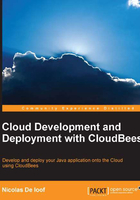
Preface
All technology evangelists talk about revolutions. Even they just have a classic product to demonstrate. So, if I tell you that the Cloud will change the IT industry, you may consider that I'm biased, being a CloudBees employee. Anyway, I'm convinced that a huge shift has been introduced by the Cloud technologies and the way in which we develop a software and use it to host the application will enter a new age. To demonstrate my point of view, let's compare with another major revolution that changed the industry all around the world.
In the late 19th century, industry development discovered the flexibility of using electric engines compared to traditional steam ones. This was a huge improvement and was adopted for most of the activities. At this time, every manufactory has its own generator, sized to produce power for the engines they used internally.

2,170 Watts dynamo generator (Credit: Wikipedia)
With the adoption of electricity, sharing resources and concentrating on the generation of electricity was a natural shift from dedicated on-premise generators. This was a major improvement to reduce costs and to improve reliability and flexibility. First, power plants were created by large manufactories for their internal needs but quickly, a dedicated industry emerged, specializing in large-scale electricity generators.
From manufactories, electricity gradually began to be used for general purposes, and power plants became bigger and much more advanced to become the nuclear plants and giant hydroelectric generators we use today.

Three Gorges Dam hydroelectric power plant, China (Credit: Wikipedia)
Such a shift from on-premises generators has been possible thanks to specialization and standardization. Some incompatible standards still exist for power plugs and voltages, as some of you may have experienced while travelling around the world, but that's nothing compared to the early electric age.
In 1900, Paris was split into six regions, each of them with a distinct company to produce electricity for public lighting. Some of them used a direct current of 110 V, some others used a high voltage, as much as 3000 V. Some used two, three, or five wires to transport power to users. With power plants to concentrate into bigger companies, standardization helped to make electricity something that you don't actually have to worry about. If you don't have to travel to another continent—not considering myself traveling to London—you can use exactly the same electric device, without even thinking this could be an issue.
Nowadays, electricity is used as a service and you don't know from where it gets produced. You just rely on some standards to plug in your toaster and get it to work. You pay a bill per month, based on your actual use of electricity. You don't mind, when you buy a new washing machine, the amount of electricity it will require—maybe you should anyway—because you know your electricity producer will give you more when needed.
Automated computing is such a revolution and is getting even quicker. First, the computer replaced human beings for repetitive computational tasks. They were huge, complex, and dedicated mainframe machines. With large acceptance, some standards emerged, such as Unix/Posix compatible systems, and helped to reduce the dependency you had as a computer user on a specific hardware.
First, datacenters could be considered as equivalent to power plants; users didn't actually know where the computer was located physically and where they were connected to, on a vt100 terminal. They were just sharing resources, concentrating in a specialized location, with dedicated engineers and technicians.
Cloud is the next step. When Amazon creates a datacenter, it's about hundreds of thousands of computers that will be available for consumption using an API to rent them. You don't need to have a dedicated server anymore; you don't even have to estimate how large it has to be. You only rent one for your actual use and you can change your mind at any time.
The major shift with the traditional datacenter is that it's not just about grouping the resource in the same building, rather it's about sharing the resources for the whole world, without worrying about who is actually using them, and making it available using the 21st century power plugs, APIs—either de facto standard Amazon Web Services or open source OpenStack.
Cloud is such a big change that it completely changes our industry. There is no need to spend hours estimating our hardware requirements when a project is just a bunch of ideas that need to be prototyped. You'll have the adequate hardware available and can stop anything at anytime without any extra costs.
This book is a great opportunity for me to share my knowledge about the CloudBees platform on which I'm working as a support engineer. I'll guide you on how to discover the platform and show you its benefits for software projects, as well as the changes it allows you to make your development process more efficient.